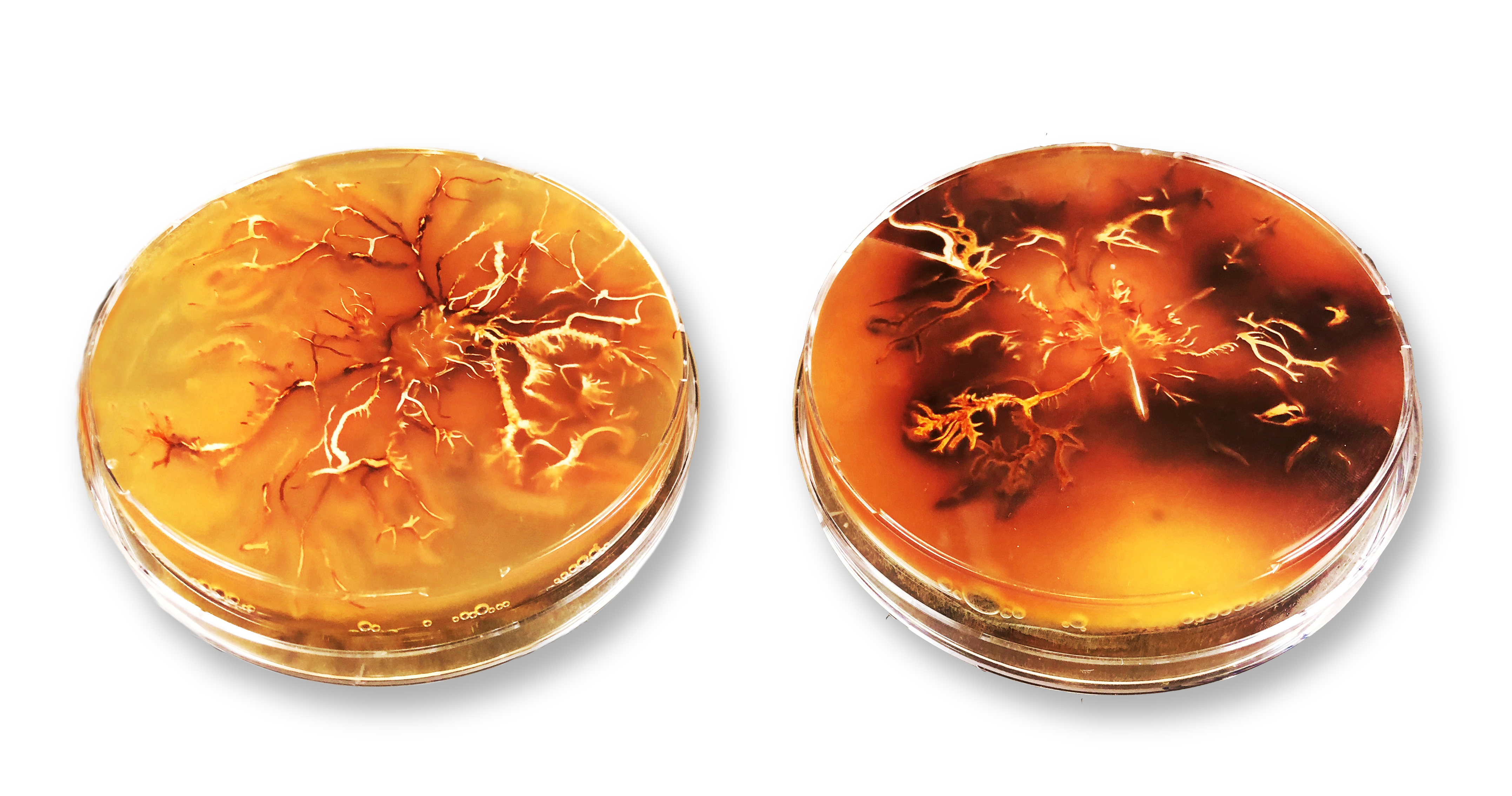In their quest for simpler, cheaper processes for the production of natural melanin in large quantities, Schwarze and his team came across a fungus, which is actually a common saprophytic fungus that grows in the forest: Armillaria cepistipes. Its amazing metabolism enables the fungus to bind heavy metals, make wood glow in the dark – and produce melanin on a massive scale. “We have selected a promising strain of A. cepistipes, that allows us to produce around 1,000 times more melanin than with other fungi” says Schwarze. The trick: A. cepistipes is cultivated in a nutrient fluid, and, in the presence of a precursor, tyrosine, the fungus releases melanin into the environment. “In this way we have developed a sustainable production method, which no longer requires time-consuming extraction steps used in previous microbiological processes,” explains the Empa researcher. In three months A. cepistipes produces around 20 grams of melanin.
The scalable and sustainable production of melanin now enables Empa researchers to advance projects to develop innovative materials for a range of industrial applications. These include, for example, a system for water purification: Since melanin is able to bind heavy metals, it can be used to develop new types of water filters. “We have integrated melanin into artificial polymers such as polyurethane,” explains Empa researcher Anh Tran-Ly. Using electrospinning, the polymer mixture was spun into ultra-fine fibers to form membranes. The Empa team found that these melanin-based composite membranescan remove up to 94 percent of lead from polluted water.
As black as ebony
In nature, fungi use melanin to protect themselves against other organisms that compete for nutrients and space in the environment. With the new technology, the pigment can now also be used to protect much larger communities from human influence: Melanin can be used to conserve tropical forests where highly priced and much sought after ebony grows.
Tropical ebony wood is particularly precious because of its unique dark color. A sustainable method that upgrades native Norway spruce wood to a visually equally attractive product allows vulnerable tropical forests to breathe a sigh of relief. “When spruce wood is impregnated with a melanin suspension, a deep dark wood can be produced that is comparable to ebony,” says Empa researcher Tine Kalac.
Serpentino – the little snake among instruments
Since Armillaria fungi use melanin as a weapon against competitors, it is only logical to use melanin to protect wood from fungi. In order to develop a melanin-based wood preservative, Empa researchers are participating in a recently launched interdisciplinary project supported by Innosuisse, the Swiss Innovation Agency. The goal is to reconstruct a historical wind instrument, the Serpentino (in English: small snake).
Together with the University of Applied Sciences and Arts Northwestern Switzerland and the Basel Historical Museum, the industrial partner in the project is the company SBerger Serpents in Le Bois (JU), which is responsible for the practical implementation of the research project – the reconstruction of the instrument. Company founder Stephan Berger is enthusiastic about the rebirth of this rare instrument: “The Serpentino was used over 400 years ago and was the godfather of modern instruments such as the saxophone and the tuba,” he explains. Although it is a technical challenge for musicians to master the instrument, the sound is incomparable, enthuses Berger. “The Serpentino creates sounds that are rich in overtones and deeply touching”. Originally, the wind instrument was used in churches to support singing because it covers the registers of the human voice and can thus “carry” a choir, the passionate instrument maker explains.
Although today’s trend towards historically informed performances means that the Serpentino is in great demand, Berger is unable to supply its customers with instruments: The peculiarly curved original instruments have become rare. Because the snake-shaped instrument made of walnut wood not only creates an incomparable sound – there is also a war raging inside the “little snake”: Condensation from the musicians’ breath creates a humid microclimate that provides excellent conditions for the growth of all kinds of microorganisms. Thus the conditions for bacteria and fungi are favorable for the decomposition of the centuries-old instruments gradually destroying the last original specimens.
The research project’s faithful serpentino replicas are to be protected from this damage. This is where Empa’s melanin comes in: “If we can use a melanin-based wood preservative, not only the newly built serpentinos can be protected against decay,” says Berger. Other woodwind instruments built today using domestic, less resistant woods could also benefit from such an environmentally friendly wood treatment. Thus, the collaboration with the Empa team is exciting in more ways than one.
https://www.empa.ch/web/s604/melanin-aus-pilzen


